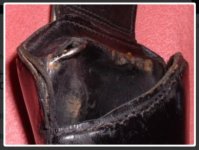>A very good resource for you, is this article by one of my correspondents (entirely his own work):
Fighting Leather: The Clamshell Holster - RevolverGuy.Com<
Oh, man. Thank you, Red! What an awesome read.
I didn't just spend 35 of my years in policing, I was a fan ever since my pre-teen years. I was the one everyone I knew just expected would end up a cop. I watched every show, listened to the police radio, and followed what was going on in the papers. I continued that through my career, following the various trends in equipment and vehicles all over the country. LAPD was a particular favorite, and when I had an opportunity to attend an LAPD class in 1987 at The Academy, I jumped at it. It was awesome - the Jack Webb Building, the iconic arch, and the giant nightstick on the wall in the grille.
I still follow policing and the tools of the trade to a degree, but the plastic revolution kind of dampened the fun. Leather can be made into artwork, plastic is just - industrial garbage. No soul.
I recognized many of the points in the Revolver Guy post. It was a trip down memory lane. Thank you very much!
Fighting Leather: The Clamshell Holster - RevolverGuy.Com<
Oh, man. Thank you, Red! What an awesome read.
I didn't just spend 35 of my years in policing, I was a fan ever since my pre-teen years. I was the one everyone I knew just expected would end up a cop. I watched every show, listened to the police radio, and followed what was going on in the papers. I continued that through my career, following the various trends in equipment and vehicles all over the country. LAPD was a particular favorite, and when I had an opportunity to attend an LAPD class in 1987 at The Academy, I jumped at it. It was awesome - the Jack Webb Building, the iconic arch, and the giant nightstick on the wall in the grille.
I still follow policing and the tools of the trade to a degree, but the plastic revolution kind of dampened the fun. Leather can be made into artwork, plastic is just - industrial garbage. No soul.
I recognized many of the points in the Revolver Guy post. It was a trip down memory lane. Thank you very much!





